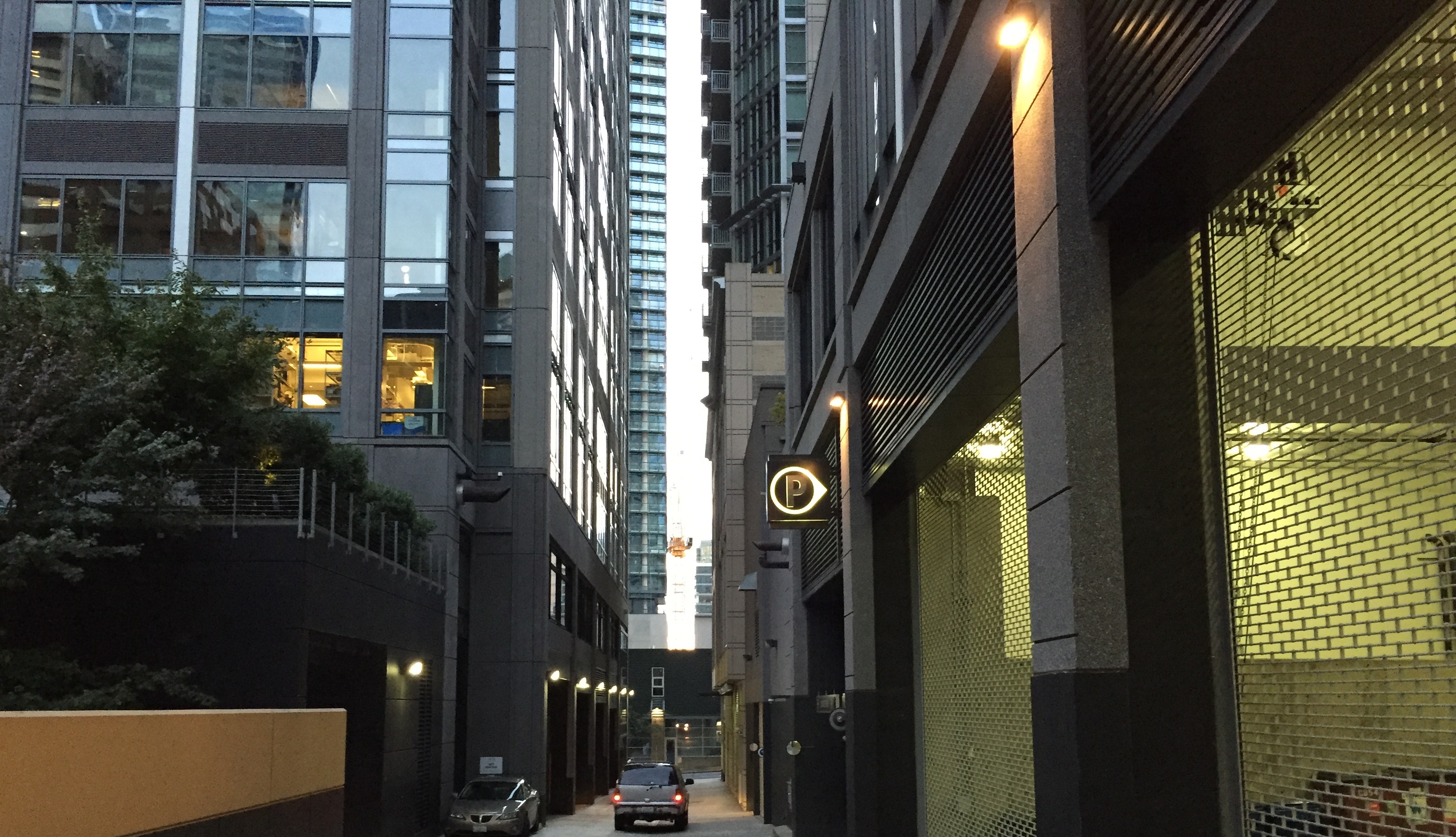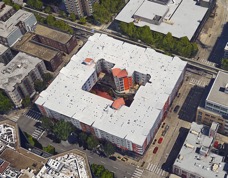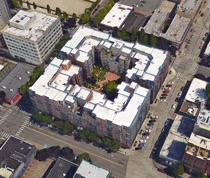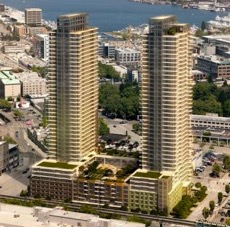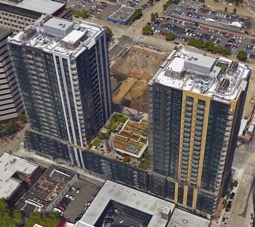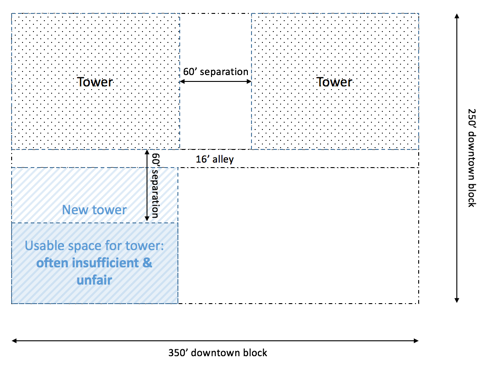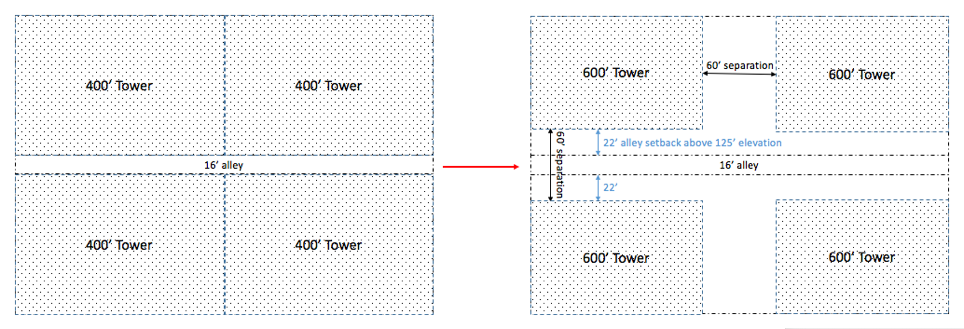Cities face a complex web of interconnected problems today — affordability, transportation, safety, livability and many others. Often these problems appear to be in competition for scarce resources, forcing us to make hard trade-offs.
As Seattle has pushed density levels beyond anything previously achieved in any part of the state, one problem piqued my interest. Last year, two mixed-use residential high-rises, one 49 stories and another 47 stories tall, were proposed just 18 feet away from an existing 31-story tower. This immediately led to a polarized set of responses.
On one side, existing homeowners, argued that so little space between buildings would severely reduce their access to natural light and privacy. They said they were not against new development, but wanted such to be done in context to its surroundings. On the other side, many urbanists identified the homeowners’ message as common for people obstructing new development (disparagingly referred to as NIMBYs). They argued that the above outcome is common in many cities and, in fact, necessary to preserve any affordability that is left. Furthermore, they blamed the affected homeowners for trying to influence politicians to change the rules so as to increase their property values.
I sensed that both sides have a point even if both try to skew arguments in their favor. Even among developers, the view on this issue varies — in a recent proposal, Clise Properties complied with and defended minimum required spacing that applies to their project, while a neighboring project by HB Management argued for an exception.
So I set out to explore the issue in great detail from both sides without giving any side any favors.
Understanding Natural Light
Natural light is often misunderstood and plays a much more important role in human health than most urbanists like to admit. In a nutshell, prolonged exposure sets our circadian clocks by controlling hormone production. This controls our level of alertness, ability to concentrate, and even our psychological wellbeing.
More specifically, natural light exposure suppresses the production of the hormone melatonin (which performs important functions during sleep) and increases production of cortisol (a stress hormone that keeps us awake). It is also established that the rate of production of the neurotransmitter serotonin is directly related to the prevailing duration and intensity of sunlight exposure1.
The human circadian system is most sensitive to short wavelength light (450 nm – 480 nm) with intensities above 2,000 lux. As you can see in the table below, outdoor light covers this requirement even on overcast days, but indoor light usually does not. This is because indoor light is optimized for our visual system which operates very well with far less intense and narrower-spectrum light2.
| Intensity | Spectrum | |
| Outdoor light, sunny | < 100,000 lux | 10 – 500 nm |
| Outdoor light, overcast | > 2,000 lux | 10 – 500 nm |
| Required by human circadian system | > 2,000 lux | 450 – 480 nm |
| Typical indoor light | 300 – 400 lux | 555 nm |
So what does this mean in practice for daily life? Here are the results of some peer-reviewed academic studies, consistent with an overall pattern:
- Effects on learning performance
- Controlling for all influences, students with the most daylight in their classrooms progressed 20% faster on math tests and 26% faster on reading tests in one year than those with the least3.
- Ability to concentrate fluctuated with exposure to daylight over the year, but fluctuated the least for students exposed to natural light, as opposed to artificial light4.
- Effects on productivity
- Workers in offices with windows and good natural light spent 15% more time on work-related tasks than people in interior offices (similar results here as well)5.
- After two evenings, subjects that were earlier exposed natural light as opposed to artificial light had better cognitive performance.
- Workers in offices with windows report higher job satisfaction and higher interest in their job.
- While not an effect on productivity, but on human motivation more generally, adding skylights to retail space that otherwise did not have natural lighting increased retail sales by 40%.
- Effects on psychological well being
- While low serotonin levels do not cause depression, symptoms improve with higher levels (likely related to fewer/less functional serotonin receptors). Most anti-depressant drugs also work by essentially increasing the amount of available serotonin. As noted before, serotonin levels are directly related to length of direct sunlight exposure during the day.
- Natural light treatment of Seasonal Affective Disorder (SAD) patients by means of a one hour morning walk improved depression self-ratings in all subjects, as opposed to artificial light treatment which did not improve any6.
- Effects on physiological wellbeing
- It is well established that Vitamin D production needs natural light.
- There is evidence that patients recover faster from trauma and disease when exposed to natural light: myocardial infarction patients in a cardiac intensive-care unit treated in either sunny or shaded rooms found that female patients stayed a shorter time in sunny rooms (2.3 days in sunny rooms, 3.3 days in shaded rooms). Mortality in both sexes was consistently higher in shaded rooms (39/335 shaded, 21/293 sunny)7.
- Moreover, there is an effect on perceived pain as well: elective cervical and lumbar spinal surgery patients staying on the bright side of a hospital unit were exposed to 46% higher-intensity sunlight on average and took 22% less analgesic medication per hour8.
Does It Matter?
Now, when I found all of this, I thought — isn’t the solution to spend more time outdoors? Sure, but according to the Environmental Protection Agency, Americans spend 87% of their lives indoors. People working or living in spaces with little natural light, especially in the winter when days are short, may remain in a state of “biological darkness” that provides an insufficient stimulus for proper synchronization of a person’s circadian rhythms and hormone production, thus making access to natural light in buildings even more important.
Energy Conservation Perspective
Moreover, lighting represents 15% to 20% of energy usage in buildings, and green buildings are actively trying to reduce that. The Bullitt Center, for example, was designed to rely on natural light and has a lighting power density in its office spaces of just 0.4 watts per square foot — less than half the 0.9 watts per square foot allowed under the Seattle code and goes to show what can be achieved.
Given that 60% of worldwide energy is used by buildings and 78.4% of it is based on fossil fuels, just the lower reliance on electrical light has the potential to cut our carbon footprint by up to 10%.
The Problem Redefined
Let’s take a step back from tower spacing. The question really is, how can we expose our bodies to high-intensity (>2,000 lux), broad spectrum light when we statistically spend 87% of our time indoors, and do this with the least amount of energy possible? There are other solutions besides space between buildings.
Solution #1: Advanced Electrical Lighting Systems
Simply increasing the luminosity of traditional lighting has not been proven effective. In one experiment, a subject was exposed to a 2,500 lux light (a 2,000 W spotlight), but this did not suppress melatonin production as well as natural light. This may in part be due to its narrow spectrum9.
Recently, broad spectrum lights designed specifically to act on our circadian system started appearing (e.g., Lighting Science Awake & Alert Biological Lamp ($42)). However, to produce 2,500 lux at a distance of 3 feet would require 5 such bulbs at a cost of $210. This is good for at most 4 people as luminosity falls to 670 lux at 6 feet. Besides the high cost, using 5 times as many bulbs eliminates the energy savings gained from going from incandescent to LED technology.
Solution #2: Light guides: daylight in a tube
New York City’s underground park project, Lowline, is experimenting with the SunPortal technology to bring sunlight in. An outdoor heliostat captures sunlight with a parabolic dish concentrator and then routes it via relay lenses to indoor luminaires. A mockup of the project demonstrates that it is possible to grow plants underground.
Seattle developer Urban Visions plans to build an 880-foot office tower on Second & Marion that would feature a 616-foot tall atrium — an 80 by 80 foot hollow core rising to the height of 44 office floors. This would provide natural light to interior offices and also natural temperature control via the stack effect.
As architects and engineers continue to explore ways to reduce the energy requirements of buildings, it is likely we will see more technologies and approaches developed and get standardized.
Solution #3: Spacing
But before we hope for salvation by future technology, we can realize that this is an old problem with solutions dating back since the time we started building structures. Below is an example from Charlie Gardner’s post “Fall and Rise of the Euro Block“. First you can see a block from Berlin and then one from Brooklyn.
The Berlin blocks are 5.5 floors high and provide a wide 80 by 40 foot interior courtyard — usable as recreational space and as a way to provide as much light on the inside of the block as is available on the outside. Notice that it is about as wide as the side-street.
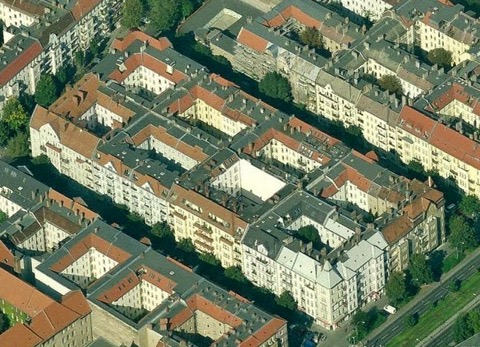
The Bushwick blocks of Brooklyn are 3 floors high, have lower density, but a higher lot coverage. Light access on the interior of the buildings was poor enough that architects decided to have 8 by 13 feet air shafts punched in.
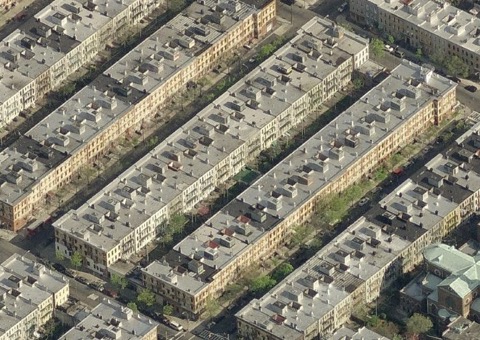
The Buschwick solution does work, but not as effectively and lacks interior courtyard space. While likely built during a housing shortage or times of high demand, the Bushwick blocks originally attracted a strong middle class population only to lose it over time until recent gentrification fueled by constricted housing supply kicked in again. In contrast, their European counterparts that provided better living conditions thanks in part to nimble design incorporating ample natural light didn’t have such dramatic demand swings.
Back To Seattle
It’s interesting to see that in the few rare developments in Seattle where developers acquired the land of a full or half city block, ample spacing was indeed provided for both low-rises and high-rises. Fountain Court (4th-5th, Wall-Battery) and Belltown Court (1st-2nd, Wall-Battery) are both 6-floor buildings that look like the Euro blocks above and have courtyards wider than 90 feet.
| Fountain Court Spacing: 95′ – 115′ |
Belltown Court Spacing: 90′ – 100′ |
On the high-rise side, the almost finished Insignia towers (5th-6th, Battery-Bell) have more than 170 feet of spacing between the two towers, while the Via6 towers (on 6th between Blanchard and Lenora) have 125 feet of spacing.
| Insignia Towers Spacing: 170′ |
Via6 Spacing: 125′ |
When developers have command over a larger amount of space they often put provisions for natural light access and privacy. However, in most cases they are unable to acquire full city blocks. And when multiple developers are involved as opposed to a single one, they end up in a prisoner’s dilemma — one developer can set their building back from the lot line to provide space, but this reduces the incentive for the neighboring developer to do so. So, the developer who sacrificed building capacity to help the common good ends up subsidizing the neighboring competing developer.
Tower Spacing Defined
Now this is not a new problem in Seattle. So called “tower spacing” legislation already exists in Belltown, Denny Triangle, and South Lake Union (Seattle Municipal Code 23.49.058, part F). In Belltown, it requires 80 feet of distance between the high-rise portions of buildings on the same block, while in the Denny Triangle it requires 60 feet.
This only applies to buildings taller than 160 feet and specifically to the portion of the building above 125 feet (roughly above the 12th floor in a residential building). It does not affect street-level set-backs.
These rules also do not protect anyone’s views of anything. In fact, views do not change much with or without tower spacing. At a distance of 60 or even 80 feet, a neighboring tower would still occupy most of one’s view, and a row of such towers would completely cover whatever is behind them. With or without tower spacing, the view one gets is still mostly of the same set of buildings.
The gain, then, is entirely in terms of more natural light and improved privacy.
Great, now let’s look at the problems of tower spacing.
Reduced Buildable Capacity And Thus, Affordability
If tower spacing is applied on its own to an area with no spacing requirements, it effectively reduces developable capacity as the same amount of land can hold either fewer or smaller buildings. This often displaces future residents further away from jobs, and thus increases the amount of time they have to spend commuting and in turn, indoors, not exposed to natural light or say their loved ones.
How much space is lost? Let’s examine buildings 400 feet / 40 floors tall (typical for Denny Triangle). Tower spacing will affect only the top 28 floors and at the extreme will make floor plates 33% smaller (from 20,475 square feet to 13,775 square feet). However, because 20% of a floor plate is usually dedicated to elevators, stairs, mechanical and corridors, inhabitable space actually goes down by 41% from 16,380 square feet to 9,680 square feet, assuming that making the towers skinnier does not significantly change the need on mechanical systems within a certain range.
Assuming a block of 4 towers, and 700 square feet per person, spacing would reduce the number of people who can live there by 29% from about 3,700 to 2,700. That is a very significant change that can affect the price of housing/office space.
Unpredictable Outcomes For Developers And Further Unplanned Reduction Of Supply
Today’s rules require a distance between towers without suggesting how that should be implemented. This leads to peculiar situations where on a completely undeveloped block with multiple property owners, all parties are rushing through the approval process because the developer who gets through first, gets to build towers, while some or all other developers do not.
This problem usually does not appear across a street, as almost all streets are wider than 60 feet, but it commonly appears across an alley:
Alleys are usually 16 feet wide and if one developer builds to the lot line, the one across it may have to cut as much as 44 feet off their tower (for 60 foot spacing) which can easily make it technically or financially unfeasible. If this leaves us with only two towers on one side of the block and a 12-floor building on the other, we can now house 2,800 people, or still a reduction of supply of 26%.
So, regardless of how tower spacing plays out, we lose almost 1/3 of the housing or office space that could have been built.
In comparison, the upzone proposals within HALA seem to increase development capacity by about 1/3 as well, clearly deeming that ratio significant enough to affect affordability.
Something’s Got To Give
If we lose space horizontally, we must be able to gain it back vertically. Can we have tower spacing without losing 1/3 of the housing or office space?
First, to resolve the deadlock over spacing across an alley, the solution would be to require both developers would share the burden — by each adhering to a 22-foot set-back from the alley for the portion of the building above 125 feet. This gives us back the ability to consistently build 4 towers per block, as opposed to just 2.
Second, because floor plates become 41% smaller on the top 28 floors we need 69% more of them to produce the same amount of inhabitable space. In other words, 28 floors become 48 floors.
Both configurations produce 2.6 million square feet of usable space. Taller buildings are more expensive to build, but as the supply remains the same, the effect on the price should be minimal.
It should be noted that if the skinner towers end up unprofitable and don’t get built it would produce a significant reduction in supply again, but since we already see developers in Seattle voluntarily spacing their towers when they have control over a large part of the block it should be safe to assume that this won’t happen.
What About Other Cities?
Example implementation: Vancouver, BC
The Downtown South Guidelines, for example, require a minimum of 80 feet between towers (section 4.5.a.i) and a maximum tower width of 90 feet at heights above 70 feet (section 4.1.3.a). Additionally, a 30-foot alley setback above 70 feet and a 40 foot side setback for mid-block sites prevents unpredictability of outcomes for development.
In combination, all of these requirements have still produced a neighborhood with a density of 78,736 people per square mile, or slightly higher than the overall density of Manhattan (71,672 people per square mi) but ensuring adequate light access for everyone. Here are Vancouver’s famous skinny towers:
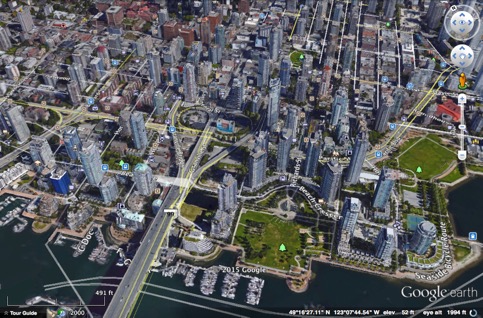
Example implementation: Chicago
Actually, Chicago has no tower spacing requirements! They have, however, zoned a much larger area for high-rise development. The result is that despite no rules, there is often more space between high-rises (especially residential) in Chicago than in Seattle (surprise!).
The Real Culprit: Availability Of Developable Land
By reducing the scarcity of developable land, land values would drop and developers are more likely to acquire larger lots. Moreover, this would vastly increase the number of development projects competing for customers. One may think that in very high demand areas, towers would still be built with no spacing, which will be true in some cases, but since such buildings would face competition from others in up-and-coming areas which will feature more space for the same price, there is a point beyond which squeezing doesn’t make sense.
This effect doesn’t happen in Seattle as all we have is one high-density area (Downtown) and no other places where such development is built and could compete. This approach should make market urbanists and affordability advocates very happy.
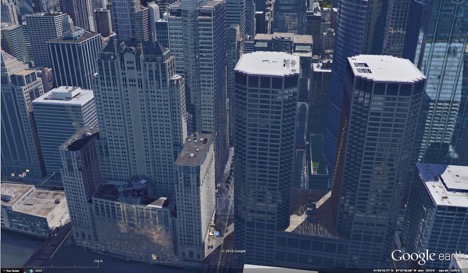
This example is important, because it points to our core problem — too little of our city is zoned for dense development despite relentless demand. In fact, more than 60% of the city is still zoned for single-family detached homes. The result is that while some people get to enjoy a garden, others are squeezed further in within the multi-family zones and further into their wallets.
The Fine Balance
So, tower spacing can reduce the amount of housing/office space that can be built by as much as 1/3, significantly affecting affordability in the long run and displacing thousands of people from an area close to jobs. Yet, access to natural light in buildings is crucial for a culture of people who spend 87% of their time indoors. It affects their cognitive performance, psychological well-being and even physiological health.
There are really only two tools at our disposal to solve this problem:
- Zone more land for dense redevelopment.
- Add tower spacing, but only with increased height and FAR limits to ensure that the same amount of housing or office space can be built after the new rules go into effect (e.g. allowing 600-foot towers in a formerly 400-foot zone).
While option two tries to minimize the supply decrease resulting from tower spacing it probably can’t do so perfectly. There is no free lunch, after all. But the point here is that, when implemented with an upzone, the improved human outcomes of tower spacing outweigh the decreased outcomes of the minimized displacement likely to occur.
Footnotes
- Lambert G, Reid C, Kaye D, Jennings G, Esler M (2002). Effect of sunlight and season on serotonin turnover in the brain. Lancet 360: 1840–42
- Figueiro M, Rea M. (2010). Lack of short-wavelength light during the school day delays dim light melatonin onset (DLMO) in middle school students. Neuroendocrinology Letters 31, 1
- Heschong Mahone Group. (1999) Daylighting in Schools – An Investigation into the Relationship Between Daylighting and Human Performance. California Board for Energy Efficiency Third Party Program
- Kueller R, Lindsten C (1992). Health and Behavior of Children in Classrooms with and without Windows. Journal of Environmental Psychology 12:305-317
- Figueiro M, Rea M, Rea A, Stevens R. (2002) Daylight and Productivity — A Field Study. Human and Social Dimensions of Energy Use: Understanding Markets and Demand – 8.69
- Wirz-Justice A, Graw P, Kraeuchi K, Sarrafzadeh A, English J, Arendt J, Sand L. ‘Natural’ light treatment of season affective disorder. Journal of Affective Disorders 37:109-120
- Beauchemin K, Hays P (1998). Dying in the dark: sunshine, gender and outcomes in myocardial infarction. Journal of the Royal Society of Medicine 91:352-354
- Walch J, Rabin B, Day R, Williams J, Choi K, Kang J (2005). The Effect of Sunlight on Postoperative Analgesic Medication Use: A Prospective Study of Patients Undergoing Spinal Surgery. Psychosomatic Medicine 67:156–163
- Boyce P, Kennaway D. (1987) Effects of Light on Melatonin Production. Biol Psychiatry 22:473-478

Anton Babadjanov
Anton has been living in the Pacific Northwest since 2005 and in Seattle since 2011. While building technology products during the day, his passion for urban planning and transportation is no less and stems from a childhood of growing up in the urban core of a small European city.

